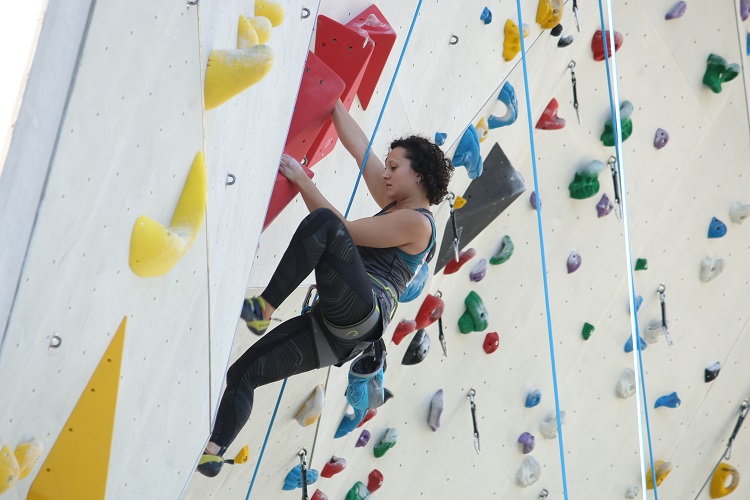Eyes focused on the free-form moves ahead of her, Jasmine Raskas makes her second, third, and fourth ascent of a juggy, green route. She gives great deliberation to keeping her left hip to the wall. Then, her opposing side with the same consideration. Back and forth, she methodically places the outside edge of her black-and-blue La Sportivas as if from memory.
Though flawless, her footwork is not what initially intrigues onlookers. Most notice the conspicuous, bright blue swirls of the vest-like brace she wears. It starts at her waist, continues up her spine and wraps partially around her head.
A few short years ago, Raskas was diagnosed with Ellers-Danlose Syndrome (EDS), a genetic, connective tissue disorder that causes her body to be pulled beyond its normal limits. In the midst of painful symptoms and surgeries, she’s found an unlikely therapy in rock climbing.
Following a major surgery in 2015, Raskas began exploring physical therapies to slow the progressive nature of the disorder. One by one, she tried and ruled out traditional exercises. As her list of 20 potential therapies dwindled, so did her confidence.
“I was near the giving up point,” she recalled. “Climbing was at the bottom of my list. At that point in my life, I thought it sounded ridiculous because there were times I could barely even walk.”
While everyday actives can prove challenging, Raskas found climbing to be less taxing on her fragile body, which is susceptible to repetitive-motion injuries. Climbing’s infinitely variable sequence of movements actually protects her from injury while she builds stabilizing muscle.
“I found there were times I could climb three to four times longer than I could walk,” she said. “Now, at least once a week, I try to climb 30 routes.” (Note to non-climbers: that’s a lot!)
What started as a therapy has blossomed into a pastime that quickly launched her into competitive para-climbing. She credits the competitive side of the sport with helping her find balance between perseverance and acceptance of her conditions.
Adaptive Climbing
Adaptive climbing provides people with ways to adapt the sport to their own physical abilities. The beauty of it is that we are all adaptive climbers. By nature, climbing forces its partakers to face and overcome physical limitations, reshaping personal challenges into personal wins. Progress — be it a single move or a hard-earned send — is how we redefine what we once presumed impossible.
While the takeaways are impartial, adaptive climbing represents a diverse group of people whose challenges, abilities, and interactions within the sport are vastly unique. For example, Raskas uses a brace to support her joints. Others climb with little regard to their upper or lower prosthetics. Seated harnesses are designed to accommodate those with limited lower limb use, as are hand-operated ascenders that allow climbers to control their ascent with their upper body.
Historically, opportunities for those with physical disabilities to participate in adventure sports has been limited. As rock climbing continues to gain popularity, so do the opportunities for adaptive climbers. Like Raskas, a growing number of para-climbers are competing on a global stage. Non-para-climbing-specific competitions are including adaptive categories. And more gyms and guide services are taking steps to train their staff and provide equipment to welcome all adventurers.
In 2017, Upper Limits hosted Missouri’s first adaptive climbing clinic, led by Chicago-based Adaptive Climbing Group (ACG). The two-day workshop taught the gym’s staff, climbers, and other volunteers how to support and climb with people with disabilities — skills such as etiquette training, techniques, and equipment.

Adaptive Climbing Group clinic at Upper Limits in St. Louis.
Kareemah Batts, program director for ACG, credits Raskas with bringing adaptive climbing to St. Louis.
“While we were in Paris for the world championship, Jasmine had said how much she enjoyed having a climbing community that is like her,” said Batts. “She asked if [ACG] could find a way to come to St. Louis and get something started.”
Since then, Upper Limits has purchased special harnesses and equipment to accommodate adaptive climbers from groups such as Veterans Affairs, Variety, and the Disabled Athletes Sports Association (DASA).
Even after three years of climbing and multiple silver and gold medals to her name, Raskas continues to battle the mobility impairments inflicted by an otherwise invisible disorder. She’s certainly won a few of those battles. In addition to minimizing the risk of injury, climbing has empowered Raskas to continue pursuing her love of and career in art.
“Climbing is this crazy thing you wouldn’t think would work, but it does. I had a lot of trouble holding a paintbrush, but now I can because climbing strengthened my fingers and shoulders. I think climbing could help a lot of people, and it doesn’t matter where you’re starting from.”
_____________________
There are a lot of great organizations in St. Louis that encourage people with disabilities to participate in adventure sports. Organizations such as Variety St. Louis and Veterans Affairs have incorporated climbing into their programming. If we missed any that offer rock climbing, let us know. Looking to give adaptive climbing a try? Contact any of these organizations to get started.
Adaptive Climbing Group
Climb So iLL
Disabled Athletes Sports Association
St. Louis Adaptive Climbing Meetup
Upper Limits
Author: Corrie Hendrix Gambill is a regular contributor to Terrain Magazine.
Photo: Lead image of Jasmine Rakas by Tim Condie.


Leave A Comment